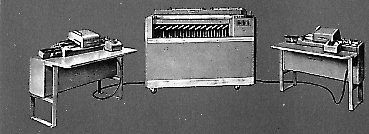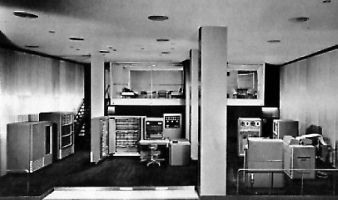|
The First Generation
The theoretic studies about the electronic calculation machines come from the English and American university laboratories,in which a series of prototypes have been created and they are called :
EDSAC (Electronic Delay Storage Automatic Calculator), MADM (Manchester Automatic Digital Machine), UNIVAC (Universal Automatic Computer), etc., so a lot of industries are interested in it too.
It passes from the experimental phase to the production of these machines in more than one model, which are designed for the commercial sale, and then its diffusion starts.
At the beginning of the fifthies the IBM created a series of machines like the 701 System, in 1952, the 650 in 1953, and the 704 in 1954 which were able to set one million of binary digits and to execute 42.000 addictions in one second.
Something were producted in Germany too, in 1955 the 2002 system by the Siemens, and in France, the Gamma ET by Bull in 1956.
The first generation's calculation machines are based on three basic functions : the input of the informations, its elaboration and the output of the elaboration's result.
The data to utilize, and the "Instructions" which are necessary to execute automatically the different operations, (in punch cards), are read by the input unity and then transfered in the internal memory.
From here the data pass in the ALU, Logic Arithmetic Unity, where the elaborations and calculations are executed.
Then the resuly are sent to the Output unity, which provide to punch them on cards or to stamp them on a sheet of paper.
While in the meccanographic machines all the phases are developed separately, through continuous interventions by hand and intermediate tests, in the calculation machines all the operations and all the tests are made automatically, form the data input to the output of the results.
The calculation machine's working is guided by a special control unit which understands the meaning of the instructions, manages their execution, verifies the accurancy and manages the data' movements through the various parts of the machine.
|
















